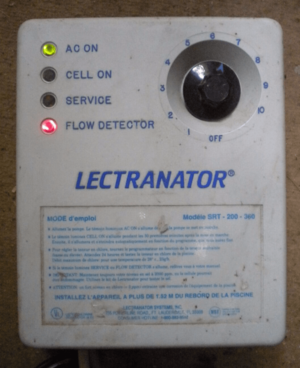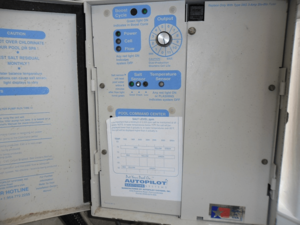How Does a Salt Water Chlorine Generator create Chlorine in a Pool?
The SWG cell consist of titanium metal plates coated with a layer of mixed metal oxide catalyst (ruthenium monoxide and iridium). An electrical current of 18-36 volts DC is passed between the plates. The electronic control circuitry control the voltage and amperage in the cell.
SWG Price Changes
The coverage of the titanium plates is about 80/20 ruthenium/iridium oxide. When the price of the ruthenium part increases 400% it's obvious that prices for the entire cell has to increase. The plates alone for a T-15 cell cost $200 in 2018 where as in 2017 they were only about $50-60. Then there is the housing, electronics, cord and all the other fixed expenses before companies even get to their marketing expenses and overhead.[1]
Since there are only a couple of suppliers for coating plates there is no room for price negotiations. Suppliers of the cells will simply pass the costs on to customers.
As of February 1, 2021, the price of Ruthenium has gone up 20% in the past 15 days and the price of Iridium has gone up 200% in the past 60 days. You have to remember the price of Ru increased 200% in 2019-2020. Since the coating on salt cell plates is about 6:1 Ruthenium/Iridium this translates into MUCH higher prices for a salt cell in 2021.[2]
Reason given for recent Ir price increase is supplies from mines in South Africa has essentially been shut off due to variant Covid strain originating there.
Chemistry behind a SWG
Salt is sodium(NA) and chloride(CL). The Na and Cl break apart as soon as salt dissolves in pool water.
The chloride ions lose an electron at the cell plate to form chlorine gas Cl2.
Electrolysis is the process of removing an electron from the chloride and putting an electron on the hydrogen ions that make contact with the opposite side of the cell plates.
So, basically, a chloride ion is on one side of the plate and a hydrogen ion is on the other side of the plate and an electron moves from the chloride ion through the plate and onto the hydrogen ion.[3]
The electrolytic cell generates chlorine gas at the anode and hydrogen gas at the cathode. The chlorine gas rapidly dissolves into the water and hydrates to form a mixture of HOCl/OCl- that is pH dependent and the hydrogen gas bubbles out of the return (hydrogen is not soluble in water).[4]
Does a SWG Create Bubbles?
A SWG cell makes chlorine gas and hydrogen gas. The chlorine gas dissolves pretty fast and you won't normally see any coming out of the returns. Hydrogen gas does not dissolve very well. The gas coming from returns is hydrogen.
The only time that you can see chlorine gas is when you have a clear cell and can see the chlorine gas and hydrogen gas being generated at the plates.
How to Clean a SWG Cell
You should only clean a SWG cell if it has visible scale on the plates.
Try and clean with the process that will do the least damage to the rare metal plates and then move to more aggressive methods if necessary.
Cleaning a SWG cell with Water
First try and use strong blasts of water to remove the scale. One member found success using a WaterPik.
Cleaning a SWG cell by Scraping Plates
You can scrape the plates with a stick, like a Popsicle stick, to remove the scale.
Cleaning a SWG cell with Vingear Acetic Acid
If the scale is stubborn then use cleaning vinegar (6% acetic acid … available in Home Depot). It’s milder than Muriatic Acid and won’t damage the ruthenium surface. Highly concentrated mineral acids are not good for the transition metal catalysts.
Cleaning a SWG cell with Citric Acid
On a molar basis citric acid will be “stronger” than either acetic acid or ascorbic acid. So it will produce a solution with lower pH due to more acid protons (H+) being released. This is why your perception is that it works better on scale than vinegar does.[5]
All acids will remove a small amount of material from the ruthenium surface because ruthenium oxide is not stable in acidic conditions. Ruthenium metal itself is highly reactive to air forming ruthenium oxide. In water, a pure ruthenium metal surface will slowly oxidize based on the amount of dissolved oxygen in the water as well as oxidation formed by hydrolysis. So, if you leave a chunk of ruthenium in highly acidic water for a long period of time, it will dissolve.
The key to cleaning calcium scale off the plates is to use an acid that is strong enough to destabilize the carbonate anion (force carbonate to become CO2) and remove the calcium without the acid also etching the ruthenium metal. The conjugate base of the acid matters as well. Chlorides and sulfates do increase the likelihood of reforming ruthenium oxides quickly enough at the ruthenium metal surface such that hydrochloric acid and sulfuric acid would be poor choices. Ascorbate ions from ascorbic acid tend to be anti-oxidants and will less likely increase the repassivation of the metal surface. Acetic acid creates acetate ions which also weakly interact with ruthenium. As far as citrate goes (the conjugate base of citric acid), I'm not entirely certain as I would have to search the literature for it. My guess is it will be more aggressive towards ruthenium than either ascorbic acid or acetic acid but much less aggressive than muriatic acid. Citrate tends to act as a chelating agents to many transitions metals like iron and cobalt so I would expect ruthenium to complex pretty readily with citrate given the many different stable oxidation states that a ruthenium atom can attain. Ascorbates and acetates are weaker chelating agents.
On balance, if you don't happen to have vinegar lying around, and the big bag of citric acid is just sitting there screaming to be used, then you can probably use it without much harm. There's really no need to make highly concentrated solutions. A few % in distilled water will very effectively soften or remove calcium scale. Then just hit it with a garden hose spray to flush it out.
Cleaning a SWG cell with Muriatic Acid
Cleaning a SWG cell with Muriatic Acid 10:1 diluted solution will remove some of the rare earth coating from the plates and reduce the life of the cell with every cleaning.
History of SWG
Diamond Shamrock Corp. created the Lectranator in 1976.[6] A patent was filed for on 11-11-1976 and granted on 7-11-1978 - DOCUMENT ID: US 4100052 A - APPLICATION NO: 05/740870. The patent description was:
Disclosed is an electrolytic cell for the generation of low cost halogen biocidally active agent from an aqueous solution having a low halogen salt content for use in the treatment of sewage or other liquid effluents, especially those of fresh water swimming pools or fresh water cooling towers.
The electrolytic cell is used in line with pumps generally associated with the distribution of waters for swimming pools or cooling towers.
The Lectranator has been in production since 1978 (16 years before the AquaRite).
Lectranator Corp was sold to Olin and then to Team Horner in May 1992 and this became the AutoPilot SWG.
Goldline Controls®, began as Independent Energy, Inc., a company founded in 1975. In 1994, the company began producing Aqua Rite® salt chlorinators for swimming pools.
Hayward® Industries, Inc. acquired Goldline Controls® in August 2004.
- ↑ https://www.troublefreepool.com/threads/salt-cell-price-increases.171363/post-1511996
- ↑ https://www.troublefreepool.com/threads/diferent-circupool-models-output.200582/post-1958842
- ↑ https://www.troublefreepool.com/threads/low-salt-swg.193378/post-1708031
- ↑ https://www.troublefreepool.com/threads/hypochlorous-acid.205081/post-1805763
- ↑ https://www.troublefreepool.com/threads/citric-acid-suitability-for-swg-cleaning.262647/post-2297978
- ↑ https://www.troublefreepool.com/threads/help-in-identifying-my-set-up.266319/post-2330456



